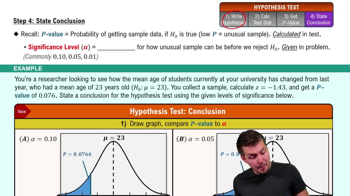A nutrition bar manufacturer claims that the standard deviation of the number of grams of carbohydrates in a bar is 1.11 grams. A random sample of 26 bars has a standard deviation of 1.19 grams. At α=0.05, is there enough evidence to reject the manufacturer’s claim? Assume the population is normally distributed.
Table of contents
- 1. Intro to Stats and Collecting Data1h 14m
- 2. Describing Data with Tables and Graphs1h 55m
- 3. Describing Data Numerically2h 5m
- 4. Probability2h 16m
- 5. Binomial Distribution & Discrete Random Variables3h 6m
- 6. Normal Distribution and Continuous Random Variables2h 11m
- 7. Sampling Distributions & Confidence Intervals: Mean3h 23m
- Sampling Distribution of the Sample Mean and Central Limit Theorem19m
- Distribution of Sample Mean - Excel23m
- Introduction to Confidence Intervals15m
- Confidence Intervals for Population Mean1h 18m
- Determining the Minimum Sample Size Required12m
- Finding Probabilities and T Critical Values - Excel28m
- Confidence Intervals for Population Means - Excel25m
- 8. Sampling Distributions & Confidence Intervals: Proportion1h 25m
- 9. Hypothesis Testing for One Sample3h 57m
- 10. Hypothesis Testing for Two Samples4h 50m
- Two Proportions1h 13m
- Two Proportions Hypothesis Test - Excel28m
- Two Means - Unknown, Unequal Variance1h 3m
- Two Means - Unknown Variances Hypothesis Test - Excel12m
- Two Means - Unknown, Equal Variance15m
- Two Means - Unknown, Equal Variances Hypothesis Test - Excel9m
- Two Means - Known Variance12m
- Two Means - Sigma Known Hypothesis Test - Excel21m
- Two Means - Matched Pairs (Dependent Samples)42m
- Matched Pairs Hypothesis Test - Excel12m
- 11. Correlation1h 24m
- 12. Regression1h 50m
- 13. Chi-Square Tests & Goodness of Fit2h 21m
- 14. ANOVA1h 57m
9. Hypothesis Testing for One Sample
Steps in Hypothesis Testing
Problem 7.RE.34
Textbook Question
In Exercises 29–34, find the critical value(s) and rejection region(s) for the type of t-test with level of significance α and sample size n.
Two-tailed test, α=0.02, n=12
 Verified step by step guidance
Verified step by step guidance1
Determine the degrees of freedom (df) for the t-test. The formula for degrees of freedom is df = n - 1, where n is the sample size. In this case, n = 12, so df = 12 - 1 = 11.
Identify the level of significance (α) for the two-tailed test. Since α = 0.02, divide it equally between the two tails. This means each tail will have an area of α/2 = 0.02/2 = 0.01.
Use a t-distribution table or statistical software to find the critical t-value(s) corresponding to df = 11 and a cumulative probability of 1 - α/2 = 1 - 0.01 = 0.99 for the upper tail. For the lower tail, the critical t-value will be the negative of the upper tail value.
Define the rejection region(s) based on the critical t-values. For a two-tailed test, the rejection regions are t < -t_critical and t > t_critical, where t_critical is the positive critical value obtained in the previous step.
Summarize the results: The critical t-values and rejection regions are determined, and these will guide the decision to reject or fail to reject the null hypothesis based on the test statistic.
 Verified video answer for a similar problem:
Verified video answer for a similar problem:This video solution was recommended by our tutors as helpful for the problem above
Video duration:
2mPlay a video:
Was this helpful?
Key Concepts
Here are the essential concepts you must grasp in order to answer the question correctly.
Critical Value
A critical value is a point on the scale of the test statistic that separates the region where the null hypothesis is rejected from the region where it is not rejected. In hypothesis testing, critical values are determined based on the significance level (α) and the type of test being conducted, such as a t-test. For a two-tailed test, critical values are found at both tails of the distribution.
Recommended video:

Critical Values: t-Distribution
Rejection Region
The rejection region is the set of all values of the test statistic that would lead to the rejection of the null hypothesis. In a two-tailed test, this region is divided into two parts, corresponding to the critical values on either side of the distribution. The size of the rejection region is determined by the significance level (α), which indicates the probability of making a Type I error.
Recommended video:
Guided course

Step 4: State Conclusion
Two-Tailed Test
A two-tailed test is a statistical test that evaluates whether a sample mean is significantly different from a population mean in either direction (higher or lower). This type of test is used when the alternative hypothesis does not specify a direction of the effect. In the context of the given question, a two-tailed test with α=0.02 means that the rejection regions will be located in both tails of the t-distribution, each containing 1% of the total area.
Recommended video:
Guided course

Difference in Proportions: Hypothesis Tests

 5:12m
5:12mWatch next
Master Intro to Hypothesis Testing with a bite sized video explanation from Patrick
Start learningRelated Videos
Related Practice
Textbook Question
27
views
